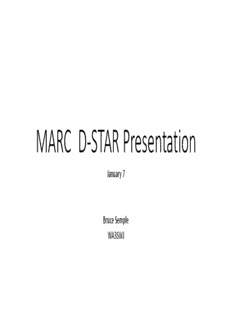
MARC D-STAR Presentation - Montgomery Amateur Radio Club PDF
Preview MARC D-STAR Presentation - Montgomery Amateur Radio Club
MARC D-STAR Presentation January 7 Bruce Semple WA3SWJ Credits • John Davis – WB4QDX • Maryland D-Star • TAPR – Digital Communications Conference – John Hays (K7VE) • Mark Holmes – KJ4VO • Jim Moen – K6JM • Fred Van Kempen – PA4YBR • Jim McClellan – N5MIJ • Guy, Larry, & Ray • Ron Milione Ph.D. W2TAP Topics • D-STAR – What is it? • What Can I do with it? • The Repeater / Gateway System • D-STAR User Equipment • D-STAR User Registration • Your First D-STAR Call - The Four Call Signs • D-STAR Routing Topics • D-STAR – What is it? • What Can I do with it? • The Repeater / Gateway System • D-STAR User Equipment • D-STAR User Registration • Your First D-STAR Call - The Four Call Signs • D-STAR Routing D-Star – What is it ? D-STAR (Digital Smart Technologies for Amateur Radio) is a digital voice and data protocol specification (published in 2001) developed as the result of research by the Japan Amateur Radio League to investigate digital technologies for amateur radio. ICOM provided the equipment used for development and testing. • D-STAR is an open protocol – although it is published by JARL, it is available to be implemented by anyone. While ICOM is the only company to date that manufactures D-STAR- compatible radios, any equipment or software that supports the D-STAR protocol will work with a D-STAR system. D-STAR systems can be built using both commercial and homebrew equipment and software. • In a D-STAR system, the air link portion of the protocol applies to signals travelling between radios or between a radio and a repeater. D-STAR radios can talk directly to each other without any intermediate equipment or through a repeater using D-STAR voice or data transceivers. The Gateway portion of the protocol applies to the digitial interface between D-STAR repeaters. • D-STAR also specifies how a voice signal is converted to and from streams of digital data, a function called a codec. • The D-STAR codec is known as AMBE (Advanced Multi-Band Excitation) from Digital Voice Systems, Inc (DVSI) (www.dvsinc.com) • The voice signal is transmitted in the D-STAR system at 3,600 bps (3.6kbps) Analogue FM Transmitter Block Diagram Look inside the D-STAR radio 4.8kbps 2.4kbps Analog (3.6 voice + GMSK digitized voice Speech 1.2 data) Signal +FEC AMBE Controller Modem Digital Voice Encoder Some Protocol Specification Terminology • Digital Voice (DV) • 3600 bps data stream real time encoded with • 2400 bps voice (AMBE encoded) • 1200 bps Forward Error Correction (FEC) for voice • 1200 bps data (text messages, GPS, telemetry, etc.) • About 900 bps available for transmission of “user data” • 6.25 kHz. Bandwidth using GMSK • Digital Data (DD) (23cm only - ID-1 Radios) • 128 kbps data stream • 150 kHz. Bandwidth • Possible extensions to other rates and bandwidths
Description: